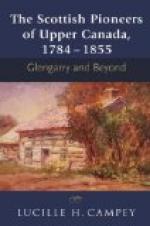other three, landed his stores, built two forts at
Cap Rouge, above and below, and then started off with
a few of his men and two boats to revisit the country
of Hochelaga. Here he intended to examine the
three rapids or “saults”—interruptions
to the navigation of the St. Lawrence—which
he had observed on his previous journey, and which
were later named the La Chine Rapids (in the belief
that they were obstacles on the river route to China).
But these falls proved insuperable obstacles to his
boats, and he gave up any further idea of westward
exploration, returned to his forts and ships near
Quebec, and there laid the foundations of a fortified
town, which he called Charlesbourg Royal. Here
he spent a very difficult winter, the Hurons in the
neighbourhood becoming increasingly hostile, and at
last, when the spring came, as he had received no
relief from France, he took to his three ships, abandoned
Charlesbourg Royal (having probably to do some fighting
before he could get safely away) and thence sailed
for France. Off the Avalon Peninsula of Newfoundland
he met the other ships of the expedition which was
to have occupied Canada for France. These were
under the command of the Sieur de Roberval, a French
nobleman, who had really been made head of the whole
enterprise, with Cartier as a subordinate officer,
but who, the year before, had allowed Cartier to go
off to Canada and prepare the way, promising to follow
immediately. The interview between Cartier and
Roberval, near where the capital of Newfoundland (St.
John’s) now stands, was a stormy one. Roberval
ordered Cartier to return at once to Charlesbourg and
await his arrival. However, in the middle of
the night which followed this interview, Cartier took
advantage of a favourable wind and set sail for France,
arriving soon afterwards at St. Malo.
But Roberval arrived at Charlesbourg (going the roundabout
way through the straits of Belle Isle, for Cartier
had told him nothing of the convenient passage through
Cabot Strait), and there spent the winter of 1542-3,
sending his ships back to France. This winter
was one of horrors. Roberval was a headstrong,
passionate man, perfectly reckless of human life.
He maintained discipline by ferocious sentences, putting
many of his men in irons, whipping others cruelly,
women as well as men, and shooting those who seemed
the most rebellious. Even the Indians were moved
to pity, and wept at the sight of the woes of these
unhappy French men and women under the control of a
bloodthirsty tyrant, and many of them dying of scurvy,
or miserably weak from that disease.[10]




